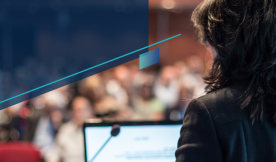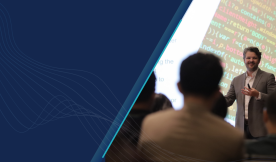Understanding and Using Blockchain for Your Startup: a Q&A with Syed Abrar Ahmed of Liber Health
Liber Health founder Syed Abrar Ahmed is an entrepreneur from Pakistan and participant in multiple GIST programs including the GIST Business Incubation program where his cohort was incubated at the University of Colorado at Colorado Springs.
This conversation between Syed Abrar Ahmed and VentureWell’s Genesis Lodise was conducted on 24 April, 2021 and was edited for clarity. VentureWell is the GIST initiative’s primary implementing partner.
GIST: It’s great to talk with you again, Syed Abrar Ahmed. I think the last time we spoke was when you were a participant in the GIST Business Incubation program. This is a great opportunity for us today to talk about an exciting topic - Blockchain - but also to hear about what your startup, Liber Health, has been doing recently. Congratulations, by the way. Liber Health just won another award recently. Which one was that?
Syed Abrar Ahmed: It’s great to be here, Genesis, and yes, that was the Disruptors’ Lab Egypt Challenge where we won a First Prize grant award. It’s going to allow us to expand and grow the important services that we provide.
GIST: That’s a great place to begin this conversation. Can you explain to the GIST community a little bit about what Liber Health is and what makes your solution innovative and unique?
SAA: Absolutely. Liber Health is a “health as a service” company which pioneered end-to-end safe and contactless biometrics powered by Blockchain. We are on a mission to prevent death and suffering caused by medical errors. Specifically we are solving the problem of patient mis-identification, duplicate medical records, denied insurance claims, identity fraud and theft and health data interoperability among health systems. Currently we are solving a more desperate use case by providing our system for a safe, contactless, and secure COVID pre-screening solution for healthcare staff, frontline workers, and other essential industries. There are a few aspects that make our solution unique. One is the price point which is lower than other solutions. To solve the problem of interoperability without sacrificing privacy and security of the records, we use a person’s iris scan as part of the encryption process. The best part is that the system is able to identify people without ever storing their biometric information. Because it doesn’t store that information, there is no chance of racial profiling which can be a problem with full facial scans.
GIST: That's great news and I just love the pivot that you were able to do, finding another great use case for your tech to meet this new challenge.
SAA: Yeah, that came out of one of the interviews we were conducting with a healthcare provider. They reached out to us and asked if a person is already standing in front of the iris scanner, can we add a temperature sensor to it and also screen for fever? At the hospital, there is one person doing the scans; that person is at risk of contracting the contagion and then spreading it to other patients. So the question we had was could we take a patient’s temperature without any human intervention, and now we're actually prototyping the 3D design, building devices, and deploying them.
GIST: Amazing. That really came out of the collaboration with your existing clients where you took their feedback, you did the customer discovery, and you are able to see a new potential for your existing solution to meet a new need. That’s a great example of when you have the idea for your solution and you take it out to the customers and you see if there really is a product market fit. Does the customer really need what you think they need? You discover all of these new things about your customers and all of a sudden there's a new way you hadn't thought of that you can use your solution and make it even better.
SAA: Yeah, absolutely and it has just expanded from that point. It's been crazy the past couple of months.
GIST: It's always great to hear that there's a little craziness. It means you're innovating, right? One of the underlying technologies that you utilize is Blockchain. Can you tell us a little bit about what Blockchain is and how Liber Health is using it?
“Blockchain will do to banking what the Internet did to the media.”
SAA: Simply put, a Blockchain is an immutable centralized database, as opposed to a conventionally centralized database where all the information is stored in one place or one server. In a decentralized system, the data is stored across multiple locations or servers or peers, as we call them. Compared to a conventional server/client architecture, in blockchain everyone has equal responsibility, hence they're called peers. Then there is the part about immutability, meaning data, once added, cannot be changed. That part is made possible with the use of math cryptography.
The way we use blockchain is to create decentralized identities for every individual. We take biometric scans, digitize them, create a unique identity, and then store that identity on the Blockchain. Any and all kinds of information can be associated and attached to that Blockchain identity, including medical records, insurance information, COVID tests, even banking information. Once the information is added, it's available to everyone who is part of the Blockchain network. But it's only viewable in its encrypted form. That’s what we did differently. So that means that everyone can see that data is there, but they cannot actually know what the data is, not even us, until the individual who owns that data provides their biometrics again as consent and authorization.
GIST: That sounds highly secure and I really like the redundancy aspect of distributing all that data amongst the peers, as you call them. That also sounds like a great way to ensure that the data is always available, that it is, as you said, immutable so that someone can't just write over it. As I understand it, there's communication between the distributed versions so that there has to be some type of consensus before data can be retrieved.
SAA: Yes! And the consensus makes sure that all the data is synced across the entire network. There is no single point of failure; there is no central authority. So if one machine goes down, there are twenty others available that can process the data.
GIST: It seems like that would also be an important tool to use for financial institutions, which is why it's probably being used so much with the synonymous term bitcoin which everyone seems to tie together with, and sometimes confuse with, blockchain. Can you really briefly explain the difference between those two terms?
SAA: Absolutely. When you're talking about bitcoin you're talking about one use case of a Blockchain. Blockchain itself is the underlying technology which enables applications like bitcoin. Blockchain can be used for things other than cryptocurrency like bitcoin and ethereum. It can be used for any digital asset, real estate, insurance or anything that has a value.
"When a startup comes to me and says 'How can we use Blockchain?' the first question I asked them is 'Do you even need Blockchain for this problem you are trying to solve?'"
GIST: Right, you brought up real estate documentation. And you're using it obviously for medical records. As I understand it, other areas that it can be used in are things like payment services, and supply chain management. Are there any other areas that you're seeing blockchain being utilized especially well right now?
SAA: With banking, it is being said that Blockchain will do to banking what the Internet did to the media. It's going to democratize it,make it transparent and more decentralized. The thing about blockchain is transactions are documented in a permanent decentralized record and can be monitored securely and transparently. For a supply chain, this can greatly reduce costs around time delays and human errors. It can also be used to monitor the cost of labor and even waste emissions at any point in the supply chain. This is very powerful. Now we can understand and control the underlying and real environmental impacts of the products we are using through that supply chain. And obviously using it for medical records is another no-brainer. One of the most annoying problems about the healthcare industry is the data blocking part. Denying access to patient medical records which, in effect, give rise to health inequities, racial disparities, and social discrimination. This is exactly what we're trying to solve with Liber Health.
GIST: Excellent I love those examples, especially the supply chain one and how companies are using that across borders while being able to track the environmental costs along the way. It’s appropriate that this particular interview is the day after the official Earth Day, and that the U.S. is having a huge leadership summit right now for climate solutions. It's also encouraging to hear that Blockchain has a role there. You were on a panel discussion recently around Blockchain and social good. Can you explain what that was about and why you think that Blockchain can be a good method for bringing about social change.
SAA: It’s all about building trust. The main purpose of Blockchain is to create a trusted network between multiple stakeholders and to remove the intermediaries. They need assurance that the data is auditable or verifiable at any point in time. One of the problems I talked about in the presentation was around Fair Trade. Fair Trade is already a thing, and you can see different products labeled as such at the market but, contrary to what we are told, only 1.6 to 18% of the extra charge for the fair trade products makes it back to the farmer and farm workers.
We can solve this lack of transparency with Blockchain technology, and a lot of companies are actually doing it. Imagine a supply chain that not only follows goods from start to finish, but also provides proof on the Blockchain that everyone is being paid fairly.You can just pick up the product, scan the QR code, and it gives you its full history.
This ties into the social good part. I was recently judging an Impact Hackathon and one of the startups is working on using Blockchain for disaster insurance. It got me thinking about hurricane Harvey in 2017. People are still struggling to get the paperwork from all the different stakeholders to file their insurance claims. Why not digitize the forms, get rid of the middleman, and create more transparency and easier access?
GIST: Those are great examples of the impact that using Blockchain can have. For early stage startups who were just starting to either form their product or are putting their team together around that product, what recommendations do you have for either integrating Blockchain into their product or integrating it into the business services they use?
“I wouldn't be here if it wasn't for the GIST Network.”
SAA: To be honest, when a startup comes to me and says “How can we use Blockchain?” the first question I asked them is “Do you even need Blockchain for this problem you are trying to solve?” First answer that question. If you actually need Blockchain for transparency, for keeping track of who owns what, then yes. Maybe you do need it.
There are a bunch of questions they need to ask and depending on the answers, they can then figure out which kind of Blockchain they need. There are three main types. Public Blockchains, which is used by bitcoin and ethereum, private Blockchains which are basically for use within a single organization, and then there is permission Blockchains which can be used between multiple organizations. Permission blockchains are the type we use for our project.
Innovators just have to be very objective about the solution they are building. Just because the technology is cool and hyped up does not mean it should be used for every problem out there. The problem should dictate the solution.
GIST: That is a fantastically honest answer and I think that's the best type of answer. When you tell someone that it works for what you are doing but for what someone else is doing it wouldn't make sense. I super appreciate that. Is there anything else you would like to leave us with?
SAA: Just that it's been a pleasure working with you, being a proud member of the Global Innovation through Science and Technology network. It's always an honor to get in touch with the team and talk to you and help out any way I can. I wouldn't be here if it wasn't for the GIST Network. All this tremendous success I have gathered over the years, I'm really grateful for that. I want more people to be part of the network and to work for creating positive social impact in the world.
Want to get great stories like this one delivered directly to your inbox? Subscribe to our monthly newsletter and we'll even throw in our favorite posts from social media and any new or exciting opportunities!


